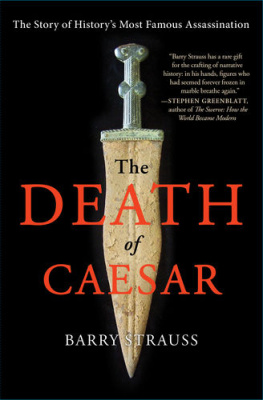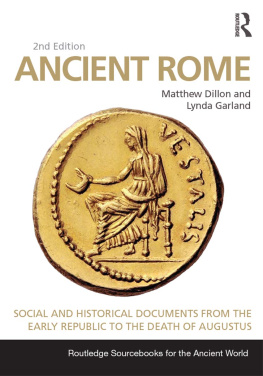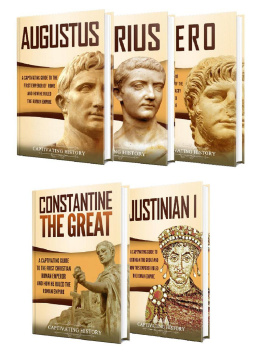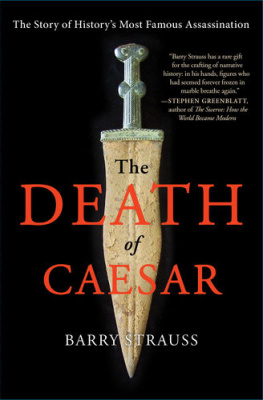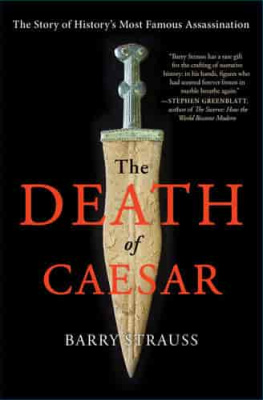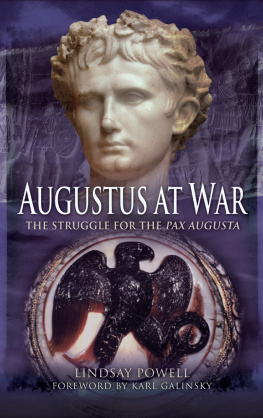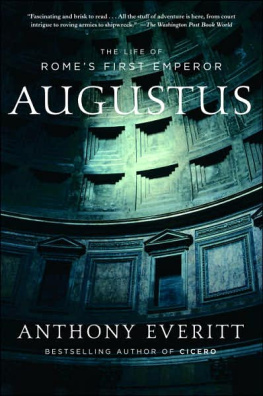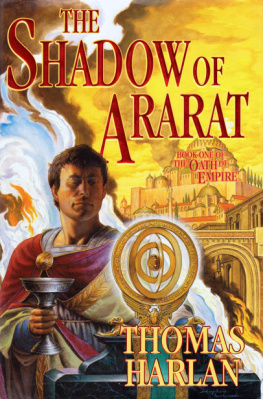Severy - Augustus and the Family at the Birth of the Roman Empire
Here you can read online Severy - Augustus and the Family at the Birth of the Roman Empire full text of the book (entire story) in english for free. Download pdf and epub, get meaning, cover and reviews about this ebook. City: Abingdon;Oxon, year: 2014;2011, publisher: Taylor & Francis (CAM);Routledge, genre: Home and family. Description of the work, (preface) as well as reviews are available. Best literature library LitArk.com created for fans of good reading and offers a wide selection of genres:
Romance novel
Science fiction
Adventure
Detective
Science
History
Home and family
Prose
Art
Politics
Computer
Non-fiction
Religion
Business
Children
Humor
Choose a favorite category and find really read worthwhile books. Enjoy immersion in the world of imagination, feel the emotions of the characters or learn something new for yourself, make an fascinating discovery.
- Book:Augustus and the Family at the Birth of the Roman Empire
- Author:
- Publisher:Taylor & Francis (CAM);Routledge
- Genre:
- Year:2014;2011
- City:Abingdon;Oxon
- Rating:4 / 5
- Favourites:Add to favourites
- Your mark:
- 80
- 1
- 2
- 3
- 4
- 5
Augustus and the Family at the Birth of the Roman Empire: summary, description and annotation
We offer to read an annotation, description, summary or preface (depends on what the author of the book "Augustus and the Family at the Birth of the Roman Empire" wrote himself). If you haven't found the necessary information about the book — write in the comments, we will try to find it.
Severy: author's other books
Who wrote Augustus and the Family at the Birth of the Roman Empire? Find out the surname, the name of the author of the book and a list of all author's works by series.
Augustus and the Family at the Birth of the Roman Empire — read online for free the complete book (whole text) full work
Below is the text of the book, divided by pages. System saving the place of the last page read, allows you to conveniently read the book "Augustus and the Family at the Birth of the Roman Empire" online for free, without having to search again every time where you left off. Put a bookmark, and you can go to the page where you finished reading at any time.
Font size:
Interval:
Bookmark:


First published 2003
by Routledge
29 West 35th Street, New York, NY 10001
Simultaneously published in the UK
by Routledge
11 New Fetter Lane, London EC4P 4EE
Routledge is an imprint of the Taylor & Francis Group
This edition published in the Taylor & Francis e-Library, 2004.
2003 Beth Severy
All rights reserved. No part of this book may be reprinted or reproduced or utilised in any form or by any electronic, mechanical, or other means, now known or hereafter invented, including photocopying and recording, or in any information storage or retrieval system, without permission in writing from the publishers.
Library of Congress Cataloging-in-Publication Data
Severy, Beth
Augustus and the family at the birth of the Roman Empire / Beth Severy.
p. cm.
Includes bibliographical references and index.
1. RomeHistoryAugustus, 30 B.C.14 A.D. 2. FamilyRomeHistory. I. Title.
DG279.S38 2003
937'.07dc21 2003046527
British Library Cataloguing in Publication Data
A catalogue record for this book is available from the British Library
ISBN 0-203-21143-X Master e-book ISBN
ISBN 0-203-34081-7 (Adobe eReader Format)
ISBN 0-415-30959-X (Print Edition)
FOR MY FAMILY
Plan of the so-called House of Sallust
Reconstruction of the view through the House of Sallust from the doorway
Marble statue depicting a male citizen holding ancestor busts
Silver denarius of L. Caldus, 51 B.C.E.
Male and female descendants of Augustus, Livia and Octavia
Reverse of silver denarius of L. Aquillius Florus, 18 B.C.E.
Silver denarius demonstrating the epigraphic style of 16 B.C.E.
Reverse of silver denarius of C. Sulpicius Platorinus, 13 B.C.E.
Silver denarius of C. Marius, 13 B.C.E.
Embossed bronze scabbard showing Livia flanked by Tiberius and Drusus
Terracotta drinking cup engraved with portraits of Augustus and Livia
Reverse of silver denarius from mint at Lugdunum, 1510 B.C.E.
Plan of the southern Campus Martius
Belvedere Altar 102
View of the entrance to the Ara Pacis Augustae from the west side
Key features of the decorative program of the Ara Pacis Augustae
Detail of a panel on the eastern side of the Ara Pacis Augustae
Procession scene on the north side of the Ara Pacis Augustae
Procession scene on the south side of the Ara Pacis Augustae
Detail from shrine in the House of the Vettii, Pompeii
Altar of the Vicomagistri showing two lares flanking laurel branches
Sacrifice scene from the Arch of Trajan in Benevento, 11418 C.E.
Silver denarius from Lugdunum mint celebrating Augustus title Pater Patriae
Plan of the Forum Augustum and Forum of Caesar
Reconstruction of the colonnade of the August Forum
An example of the shields with portraits in the attic decoration of the colonnade of the August Forum
Relief depicting the cult statues of the Temple of Mars Ultor
Paintings from the facade of a house in Pompeii
Aureus of 42 B.C.E.
Fragment of the Ara Pietatis relief, depicting the pediment decoration of the Temple of Mars Ultor
Sardonyx cameo of Livia holding a bust of the Divine Augustus
Statues from the imperial family group in Ocriculum, Umbria
Military decoration showing a general surrounded by the heads of three children
Military decoration with a portrait of a woman
Obverse of bronze sestertius showing twin babies emerging from crossed cornucopiae
Bronze dupondius, 2223 C.E.
Obverse of a bronze sestertius, 2223 C.E.
Obverse of a bronze dupondius, 2223 C.E.
Opening of the building of Eumachia onto the forum in Pompeii
Statue of Eumachia, erected by a group of fullers
Many have been instrumental in transforming this work from a dissertation into a book. I gratefully acknowledge the care that my mentor, Erich Gruen, has continued to put into the project, and I also thank him for his friendship and for providing a model as a conscientious scholar, teacher and human being. My graduate school colleague and great good friend Judy Gaughan has untiringly served as a sounding board and reader of drafts. Reader Keith Bradley's thoughtful comments pushed me in new directions, and I hope my revisions have done him justice. Susan Treggiari's eagle eyes and deep knowledge improved the book in the final stages. Finally, Richard Stoneman and Celia Tedd at Routledge have been models of both efficiency and patience. I am also tremendously grateful to each for their kind encouragement; any errors or infelicities that remain are due to my own stubbornness.
Many thanks to my challenging and supportive colleagues at Macalester College, especially my chair, Andy Overman. I am also grateful to Macalester's students, who encourage me to think in new ways and have worked with me on several concepts in this book. Some ideas originally developed during the year I spent in Rome with Steve Dyson, Alison Griffith, Richard King, and our students at the Intercollegiate Center, while the late and much lamented Judy Ginsburg offered encouragement and insight while I was working on the dissertation form of this project.
I acknowledge the kind assistance of many librarians, curators and photographic staff, whose work is evident in the illustrations. The sources of all illustrations are provided in the captions, but I would like to express my gratitude to the Deutsches Archologisches Institut in Rome, the Department of Coins and Medals at the British Museum, the Rheinisches Landesmuseum in Bonn, the American Numismatic Society, Alinari/Art Resource of New York, Art Images for College Teaching, the Kunsthistorisches Museum of Vienna, the Vatican Museums, the Italian Ministry for Cultural Heritage and the Environment, and the Muse romain dAvenches.
My emotional debts are just as heavy. From my Berkeley family, Judy Gaughan and Eric Orlin have been incomparable colleagues and friends. Janey and Bear have also been there since the very beginning. I cannot thank enough my Florida family, Lisa, Linda and Larry Severy, for their incredible support you all constantly amaze me. And, finally, my thanks to the one who lived through the dreaded summer of revision and even so wants to make a family with me in Minnesota, John Hoven.
AE Anne pigraphique. Revue des publications pigraphiques relatives lantiquit romaine. Paris: Presses Universitaires de France, 1888.
BCH Bulletin de correspondance Hellnique. Paris: de Boccard, 1877.
BMC British Museum Catalogue of Coins of the Roman Empire, 1923.
CIL Corpus Inscriptionum Latinarum, 1881.
DCIP Catalog in Dynastic Commemoration and Imperial Portraiture in the Julio-Claudian Period, edited by Charles Brian Rose. Cambridge: Cambridge University Press, 1997.
DGCN Documents Illustrating the Principates of Gaius, Claudius and Nero, edited by E. Mary Smallwood. Cambridge: Cambridge University Press, 1967.
EJ Documents Illustrating the Reigns of Augustus and Tiberius, edited by Victor Ehrenberg and A. H. M. Jones. Oxford: Clarendon Press, 1955.
Font size:
Interval:
Bookmark:
Similar books «Augustus and the Family at the Birth of the Roman Empire»
Look at similar books to Augustus and the Family at the Birth of the Roman Empire. We have selected literature similar in name and meaning in the hope of providing readers with more options to find new, interesting, not yet read works.
Discussion, reviews of the book Augustus and the Family at the Birth of the Roman Empire and just readers' own opinions. Leave your comments, write what you think about the work, its meaning or the main characters. Specify what exactly you liked and what you didn't like, and why you think so.



